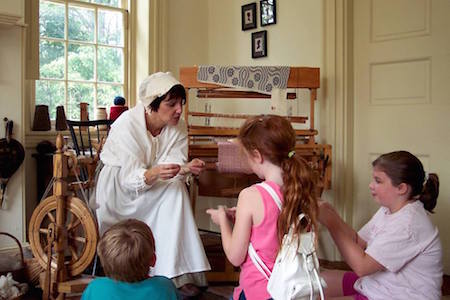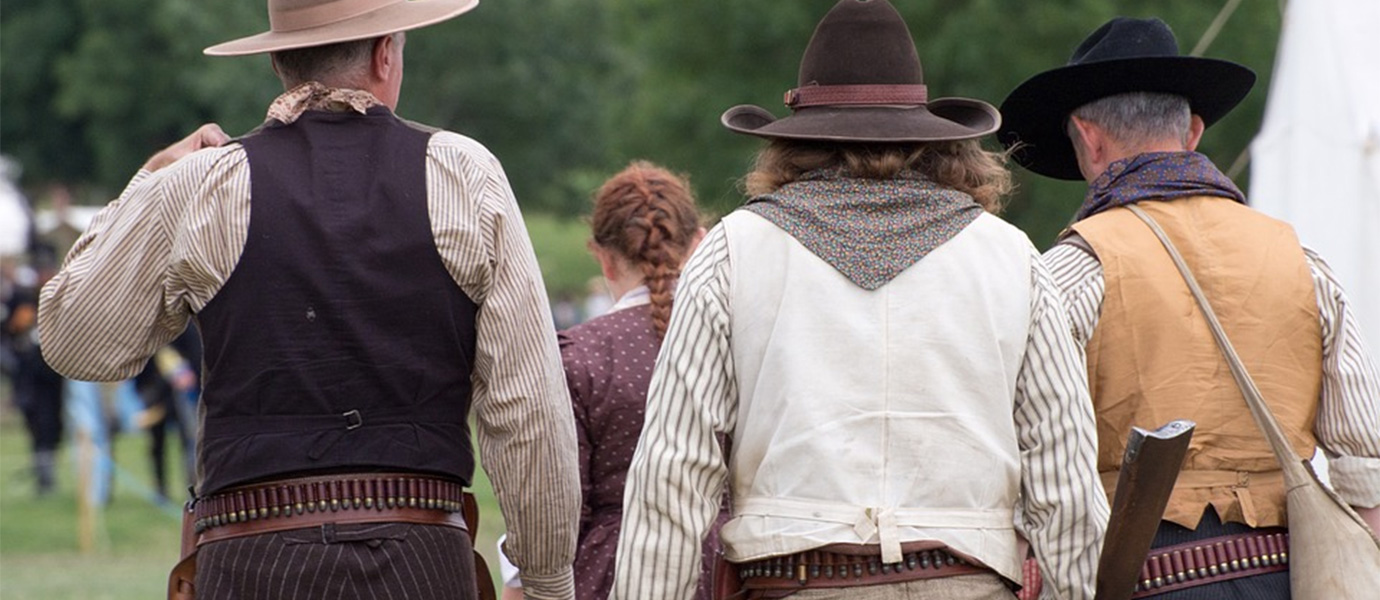
School
Students visiting the Barclay Farmstead can explore the period rooms of the 16-room farmhouse with costumed interpreters, and engage in 19th-century activities such as churning butter, spinning wool, drilling wood, and adding their own stitches to a quilt. Through the objects they encounter at the museum, they can learn about the home’s previous owners. They can also learn about the outbuildings and restored herb garden.
supports classroom learning in:
Art, Social Studies.
topics covered:
Colonial America, history, farming, religion, early trades.
contact info
Phone: 856-795-6225
Email: [email protected]
INFO
ABOUT
Barclay Farmstead
The Barclay Farmstead, constructed in the Federal style, reflects the Quaker agrarian life of the 19th century. Visitors can tour the restored interior of the farmhouse to see furniture, textiles, period objects, and primary documents. Learn about the history of the home’s previous owners, including the Cooper/Barclay family and land developer Joseph Thorn, through whose life one can learn about Quaker culture and its influence in American communities.
contact info
Hrs: Wed. 12PM-4PM.
HELPFUL LESSON PLAN(S)
Prepared by FieldTripDirectory.com
Living History Lesson Plan
FUN FACTS
Two hundred thousand Civil War soldiers were boys no older than 16, and an estimated 300 women were brave enough to disguise themselves as men and fight in the war. The average soldier weighed only 145 pounds due to poor diet, long marches, disease, and tough living, and earned between $13-$16 per month. Reading about these facts is interesting, but actually living them makes the information come alive. Living History Centers can allow students to experience how people lived during important historical eras, including enlisting as a soldier during the Civil War.
View Lesson Plan>>
Scouts
Scout groups can work on history-related badges at Barclay Farmstead. On a tour, scout can explore the period rooms of the 16-room farmhouse with costumed interpreters, and engage in 19th-century activities such as churning butter, spinning wool, drilling wood, and adding their own stitches to a quilt. Through the objects they encounter at the museum, they can learn about the home’s previous owners. Scouts are also welcome to attend weekend living history events at the farmstead, which involve demonstrations, period games, and more.
supports scout badges in:
Art, Social Studies.
topics covered:
Colonial America, history, farming, religion, early trades.
contact info
Phone: 856-795-6225
Email: [email protected]
INFO
ABOUT
Barclay Farmstead
The Barclay Farmstead, constructed in the Federal style, reflects the Quaker agrarian life of the 19th century. Visitors can tour the restored interior of the farmhouse to see furniture, textiles, period objects, and primary documents. Learn about the history of the home’s previous owners, including the Cooper/Barclay family and land developer Joseph Thorn, through whose life one can learn about Quaker culture and its influence in American communities.
contact info
Hrs: Wed. 12PM-4PM.
HELPFUL LESSON PLAN(S)
Prepared by FieldTripDirectory.com
Living History Lesson Plan
FUN FACTS
Two hundred thousand Civil War soldiers were boys no older than 16, and an estimated 300 women were brave enough to disguise themselves as men and fight in the war. The average soldier weighed only 145 pounds due to poor diet, long marches, disease, and tough living, and earned between $13-$16 per month. Reading about these facts is interesting, but actually living them makes the information come alive. Living History Centers can allow students to experience how people lived during important historical eras, including enlisting as a soldier during the Civil War.
View Lesson Plan>>
Camp
Campers can visit the farmstead to explore the period rooms of the 16-room farmhouse with costumed interpreters, and engage in 19th-century activities such as churning butter, spinning wool, drilling wood, and adding their own stitches to a quilt. Through the objects they encounter at the museum, they can learn about the home’s previous owners. They can also learn about the outbuildings and restored herb garden.
contact info
Phone: 856-795-6225
Email: [email protected]
INFO
ABOUT
Barclay Farmstead
The Barclay Farmstead, constructed in the Federal style, reflects the Quaker agrarian life of the 19th century. Visitors can tour the restored interior of the farmhouse to see furniture, textiles, period objects, and primary documents. Learn about the history of the home’s previous owners, including the Cooper/Barclay family and land developer Joseph Thorn, through whose life one can learn about Quaker culture and its influence in American communities.
contact info
Hrs: Wed. 12PM-4PM.
HELPFUL LESSON PLAN(S)
Prepared by FieldTripDirectory.com
Living History Lesson Plan
FUN FACTS
Two hundred thousand Civil War soldiers were boys no older than 16, and an estimated 300 women were brave enough to disguise themselves as men and fight in the war. The average soldier weighed only 145 pounds due to poor diet, long marches, disease, and tough living, and earned between $13-$16 per month. Reading about these facts is interesting, but actually living them makes the information come alive. Living History Centers can allow students to experience how people lived during important historical eras, including enlisting as a soldier during the Civil War.
View Lesson Plan>>
Homeschool
Homeschoolers visiting the Barclay Farmstead can explore the period rooms of the 16-room farmhouse with costumed interpreters, and engage in 19th-century activities such as churning butter, drilling wood, spinning wool, and adding stitches to a quilt. Through the objects they encounter at the museum, they can learn about the home’s previous owners. They can also learn about the outbuildings and restored herb garden.
topics covered:
Colonial America, history, farming, religion, early trades, art, social studies.
contact info
Phone: 856-795-6225
Email: [email protected]
INFO
ABOUT
Barclay Farmstead
The Barclay Farmstead, constructed in the Federal style, reflects the Quaker agrarian life of the 19th century. Visitors can tour the restored interior of the farmhouse to see furniture, textiles, period objects, and primary documents. Learn about the history of the home’s previous owners, including the Cooper/Barclay family and land developer Joseph Thorn, through whose life one can learn about Quaker culture and its influence in American communities.
contact info
Hrs: Wed. 12PM-4PM.
HELPFUL LESSON PLAN(S)
Prepared by FieldTripDirectory.com
Living History Lesson Plan
FUN FACTS
Two hundred thousand Civil War soldiers were boys no older than 16, and an estimated 300 women were brave enough to disguise themselves as men and fight in the war. The average soldier weighed only 145 pounds due to poor diet, long marches, disease, and tough living, and earned between $13-$16 per month. Reading about these facts is interesting, but actually living them makes the information come alive. Living History Centers can allow students to experience how people lived during important historical eras, including enlisting as a soldier during the Civil War.
View Lesson Plan>>
